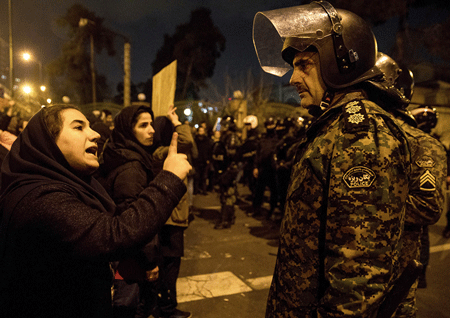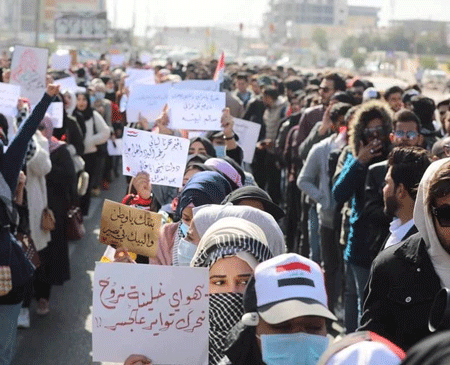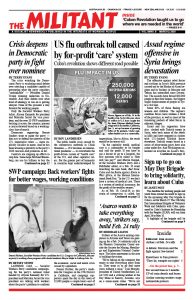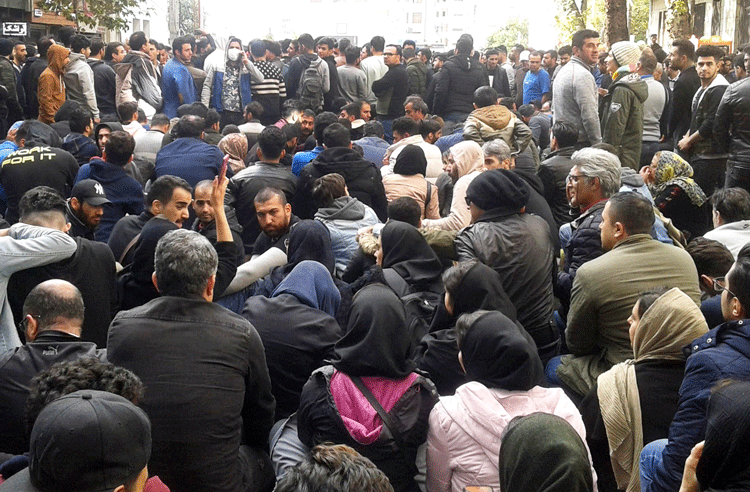The following interview was conducted in December 2019 with a participant in one of the protests by workers and youth that spread across Iran’s cities, working-class suburbs and rural towns in mid-November. It was received by the Militant in the mail early this year.
The demonstrations began in response to a Nov. 15 hike in gasoline prices announced by the government. As described below, those who took to the streets were propelled by mounting opposition to Tehran’s military actions and political interference across the Gulf region, from Iraq and Syria to Lebanon and Yemen. With their living and job conditions squeezed by tightening imperialist economic sanctions, more and more working people in Iran are fed up with the bourgeois clerical regime lavishing funds — and forfeiting the lives of young soldiers and militia fighters — to serve the expansionist aims of these privileged classes, rather than meeting economic and social needs of the population.

The November demonstrations were a continuation of Iran-wide mobilizations in December 2017 and 2018, also based among poorer working people in cities and rural areas. (See “Revolution, Counterrevolution and War in Iran: Social and Political Roots of Workers’ Protests that Swept 90 Cities and Small Towns,” by Steve Clark, from the May 21, 2018, issue, posted on the Militant’s home page.)
The recent actions in Iran also drew inspiration from large street protests that broke out in Iraq and Lebanon in late 2019, whose key demands included a halt to accelerating violations of Iraqi and Lebanese national sovereignty by Tehran, as well as Washington’s military moves.
Moreover, despite bombast from Iran’s counterrevolutionary rulers that regime-staged public lamentations for Gen. Qassem Soleimani in January would rally Iranian working people around the government (claims echoed by the imperialist media), thousands were back in the streets later that month to denounce Tehran’s failed cover-up of the Revolutionary Guard’s shootdown of a Ukrainian passenger plane. Memories were still too raw from the hundreds shot and killed in November — some reports say as many as 1,500 — by Iranian government security forces and paramilitary squads.
Due to political conditions in Iran, names of individuals and places below are not included.
?
QUESTION: Where do you work?
ANSWER: I’m a bus driver. I moved here a number of years ago, after I was fired from a factory job in the province where I was born and raised. I couldn’t find work there to support my family.
Q: Tell us a little about the protests in November.
A: On the first morning of the protests I was on my bus route in a nearby town. A lot of workers live there and travel back and forth to work in factories and other jobs in the city. In one of the town squares protesters blocked my bus. They parked a car in front of me, another behind me. So I got off the bus and joined in.
The protesters told me they knew it would be too risky for me to simply stop driving the bus and join them on my own. So they made sure I’d be stuck there. It was about 10 in the morning on Saturday [Nov. 16]. There were also other buses that had been passing by and were stopped, closing off the road.
Many people in cars had been blocked too. A lot of them were on their way to work or had other plans for the day. But most didn’t complain. They just turned off their engines and joined the demonstration.
The protesters let ambulances and others carrying out urgent business get through. An Afghan family, all women, were on their way to Qom, a holy city here in Iran, as you know. Not only did protesters let the women through but also gave them directions to the beltway to bypass the city. The protesters helped out travelers with special problems.
People on the streets also served us food and water. Everyone helped out in their own way, from their own pockets and those of their families. One person bought a big box of ice cream. Others brought biscuits, bread, cheese. It was spontaneous. Participants wanted to make sure nobody went hungry.
On one corner demonstrators kept a fire going. They baked potatoes so anyone who wanted to could get one. The weather was cold. I had a flask of tea in my bus so I offered it to someone, who then shared it with several women in the crowd.
‘Just regular people’
Q: How many and what kinds of people were there? Why did they say they were protesting?
A: There were people of all ages — young and old, men and women, children with their parents. I talked with workers from factories, small workshops, street vendors, gardeners, farmers — people from all walks of life.
A number of women had brought large mats to sit on. When the yegan-e vizhe showed up [special police units established by the government after protests in 2007], the women pulled their mats in front of the police vehicles, very neatly, and sat down to prevent the road from being reopened. Although the ground was frozen and cold, the women just talked among themselves nonchalantly, not paying any attention to the yegan-e vizhe. It was quite a sight!

If the police tried to open another road, these ladies would move some of their mats and sit there too. They weren’t being controlled by anyone. There’d been no preparations. They were just regular people.
The turnout that day was big, even where I was, near the entrance to the town. But people told us the main street and central square were much more crowded, stretching all the way to where we were. They said women had come out wearing kafan [shrouds, a symbol of being ready for martyrdom].
A bus marked with yegan-e vizhe insignia came by and pleaded with us to let them through. They said they were carrying people who were sick. But when the passengers got off the bus, we saw they were soldiers. One woman went over and took a selfie with the soldiers, while other protesters took movies of them. The soldiers kept shifting from one part of the square to the other, attempting to reopen a road. But the women followed them and tried to keep them from attacking anyone.
At one point, as the women opened the road for an ambulance, the driver of a pickup truck suddenly gunned his engine and tried to force his way through. One of the women, somewhere between 50 and 60 years old, I’d say, stood in front of the truck to stop it. The driver hit her and went on. People followed the driver and caught up with him, since the roads were very clogged. They gave him a good lesson.
People tried to take the woman who’d been hit to hospital, but she said no. “Even if I broke a hand or foot,” she said, “I want to stay and protest.” Another woman, who lived nearby, got some medical gear and treated her. When an ambulance showed up to transport the injured woman to a hospital, she still wouldn’t let the emergency care workers take her away. So they treated her there in the square. “I’m sitting right here until we get some results,” she said.
Q: Was the pickup truck driver alone? Was he a civilian?
A: Yes, he was alone. I saw it happen. That’s all I know.
When the government announced the gasoline price increase, protests began right away, all over the country. When my bus was blocked there weren’t yet any army or yegan-e vizhe units. They came later, around noon. They didn’t use any violence that day, at least not where I was. They didn’t shoot at anyone, nothing like that.
People were walking alongside them, not even chanting slogans, just silently protesting.
Q: So why were some women in the main square wearing kafan?
A: There had been sharp clashes with the government in this region in the late 1980s. Troops shot demonstrators, and there had been casualties.
What were people saying?
Q: What kind of discussions did you have?
A: People said it was a mistake for the government to increase gasoline prices. That affects the price of everything, they said.
The government denied this, of course. “Other prices won’t go up,” the authorities announced. “We won’t let that happen.”
But prices did go up, right from day one. Farmers who wanted to transport a load of fruit or vegetables, for example, had to pay more, since gasoline prices were higher. So produce became more expensive at the market, as did other things. Everyone was unhappy about this.
Even a few days later, after the government announced it would subsidize people to compensate for the price hikes, everyone thought it was a lie. “They only want to stop us from protesting,” people said.
Q: The women who joined the protests, including those who sat down on the mats to block the police, were most of them wearing the traditional veil, the chador?
A: Some did, and others wore mantos [a long coat with a head scarf]. All of them — both those in more traditional dress, and those wearing what the regime calls “bad hijab,” that is, not fully veiled — sat on the same mats together in front of the yegan-e vizhe cars.
In the areas where I was, both on Saturday and later in the week, the proportion of women to men was almost 50-50. The women shouted and chanted more, since men knew they were more likely to be targeted.
Most cars at the protests had both men and women in them. Sometimes only the driver was a man, but there were women drivers too. It’s not like before. Women drive a lot more these days.
Q: What were some of your other discussions?
A: One person said protests like these don’t get anywhere in Iran, since they don’t have a leader. I replied that many revolutions initially don’t have a leadership. Leaders emerge in the course of the struggle. Meanwhile, if there’s no leader right now, people themselves gather and decide what to do tomorrow, the next day and so on. They take action.
I also mentioned some books to read about lessons learned during revolutions elsewhere. We can bring these experiences to bear in our own country, I said. We need to know which political lessons fit the conditions of this country, of course. Then we can use them to get some results.
I pointed out that certain provocative actions by individuals and small groups in protests over the past year or so are not in the interests of working people. Maybe agents of the government itself encourage some of these acts, in order to create chaos as a pretext for repression. But I didn’t see anything like that where my bus was stopped. Not a single stone was thrown at the yegan-e vizhe. No taunts, no insults. And I was there until midafternoon.
Q: Did anyone say anything about government policies in the region, in Iraq or in Syria, for example?
A: Yes. Some people complained that the government is taking money from us and spending it in Syria. And then hired guns are brought in by the government from Syria, or from Lebanon or Iraq, and used to attack actions by workers and students here.
In fact, most people said something along these lines. We have our own problems here in Iran, people would say. Unemployment and inflation. They cut our wages and benefits. The government’s policies in the region aren’t popular.
City and small towns
Q: You said your bus was stopped in a smaller town near the city where you live. Tell us a little more about the people who live and work there.
A: Well, my home is in an industrial city with a large working class. There are construction workers, as well as factory workers who’ve come there from all over Iran looking for jobs. And many others.
The town where my bus was blocked, on the other hand, is semi-industrial as well as agricultural. There are many farmworkers, and other working people too — quite poor, semi-employed, or who haven’t been able to find jobs. In a few neighboring towns there are steel mills or other factories, but many people in the belt surrounding the city are agricultural workers who also find industrial jobs when they can.
Q: What happened as you drove home in your bus later?
A: I was stuck for about an hour on the highway, which had been blocked by demonstrators. They had erected metal fencing to close the road and also set up speed bumps — to prevent yegan-e vizhe from racing through, I think. People had set up some checkpoints, but they just looked quickly at passing vehicles, lifted the barriers, and waved you on. They didn’t damage any cars.
When I got back into the city there were obvious signs of conflict between demonstrators and the yegan-e vizhe. I didn’t see any clashes with my own eyes, but you could tell small fires had been set along some roads. There was residue from burnt tires. Streets were still wet where troops had deployed water cannons against demonstrators. And protesters were still congregating on overpasses above the highways.
The yegan-e vizhe vehicles were positioned everywhere. Confrontations continued the next day and the days afterward in the lower part of the city, the poor and working-class neighborhoods. But in the upper part of the city, the better-off middle-class areas, life mostly went on as normal, except for the special squads on patrol.
As I walked around I saw a group of 60 to 70 people riding motorcycles. The riders were wearing civilian clothes, with helmets and shields. They’d been driving people off the streets. Maybe they were the Basij [a paramilitary auxiliary of the Iran Revolutionary Guard Corps, used along with army units and the police to break up protests and harass people opposed to government policies].
I approached one of the bikers and looked straight at him. He covered his face and turned away. I told him it was impolite to turn his back that way. “Just look where you’ve ended up,” I said. “You’re beating up fellow citizens from your city just because they protest.” He didn’t say anything, looked ashamed and disappeared into the crowd.
All types of people were out on the streets, but mostly young — from early teens through their 20s and 30s. A lot of university students. They were standing around, protesting, confronting the Basij and yegan-e vizhe.
I stopped at a place where water cannons had been used earlier against people who’d been sitting down in the street. I talked with some protesters still there. They told me that when the sit-down began, it had been quiet, with no problems. But later on, when the police doused them with water and the motorcycles came, protesters defended themselves.
“If they beat us, we fight back,” one of them told me. He said they had a right to do so. I pointed to a guy agitating the crowd — “An eye for an eye!” and so on. He had covered his face, so you could only see his eyes. “Wouldn’t it have been better to continue your sit-down protest?” I asked. The person I was talking with said no, “They beat us. We had to fight back.”
I walked up the hill to a bridge where a nearby police station had been burned. Then through some other squares and streets, including one where another police station had been set on fire. In one of the poorer districts the streets were still very crowded, and clashes continued for a few days.
There were also many people in cars with their families still on the roads. Not many single men, mostly families. Most hadn’t just gotten caught up in the traffic. They had come from other parts of the city or nearby towns to be with the people. By now, of course, a lot of them were shouting so they could get through, but I didn’t hear anyone complaining about the protests or why the roads had been closed.
Q: What about Sunday and later in the week?
A: The authorities announced that government trucks and other vehicles shouldn’t go out on the streets. Under no circumstances, they said. On Sunday, which is a workday here in Iran, some government employees were told not to bring their cars to work. The parking lots were used to stage the yegan-e vizhe vehicles.
Many workers participated in the mobilizations. But most employees for various companies were at work during the protests. Neither the government nor private bosses ever called off work. I also didn’t hear about workers coming out together from any factories to join the actions.
Q: Have any of your co-workers, other bus drivers, had the same type of experiences?
A: There was no bus service on Saturday and Sunday. Workers had to walk to work and back home. Most trucks had gotten stopped too, both in the city and surrounding towns. Some truck drivers, when they got to work, just left their vehicles in the garage and went back home. Workers for the government electrical power and gas companies, telecommunications — none of them were able to drive their trucks out on the streets.
My co-workers at the bus depot were all for the protests. They thought the government should roll back the hike in gasoline prices. “Why doesn’t the government pay any attention to the people?” many said.
In response to the protests the authorities announced they would provide a subsidy to make up for the gasoline price increase. But in the section of the company where I work only two of the 15 workers has gotten the subsidy. I was astonished that I didn’t qualify, for example.
The government says it will give the gasoline subsidy to 60 million people. But everyone says that’s a lie. When I talk with people waiting in line to buy bread, for instance, most say they haven’t received the subsidy either.
Some people say they did get the subsidy, and they’re surprised to hear others haven’t. Of the two who got the subsidy where I work, one is new; he moved here from out of town and has a contract. The other one is a janitor. But 13 have gotten nothing so far.
Q: The fact that not many were wounded or killed in your area seems to be an exception to what happened elsewhere. Hundreds were killed around the country; some sources say well over 1,000. The government even shut down the internet to keep the truth from getting out. What was different where you were?
A: Well, there were casualties, especially in the downtown areas of the city. I didn’t observe any deaths or injuries myself, but co-workers told me about some.
Q: One final question. What happened here in November was very important. How have these events affected the thinking of workers and others you know? Their spirit and morale? Has it changed their view of the government?
A: I have co-workers of all ages, including some who are veterans maimed during the war. [In 1980 Iran was invaded by Iraq’s Saddam Hussein regime, supported by Washington, soon after the 1979 revolution that brought down the U.S.-backed Iranian monarchy.] With what’s happened in recent years, I no longer hear almost any of these co-workers say they can trust this government. Or that it tells the truth.
Many of these workers are religious. One is very devout, and in the past, when I said anything negative about actions by top government and religious figures, he’d warn me to talk about these individuals respectfully. He insisted on always using their honorific titles, not just their names. Now this very same worker talks about these officials all the time without any adjectives. He says they don’t care about the people.
Such attitudes aren’t just about [Hassan] Rouhani, the president. These views are about the entire leadership, no matter who they are. People don’t trust them anymore, any of them.
Workers say straight out that these government leaders lie. Most didn’t used to say that. Now they do. This includes my own wife, who I couldn’t talk with about these questions for many years. Now she says the government lies. That they cheat the people. That they trample on the rights of the people, and don’t care about anything but their own pockets.
Before it was impossible to carry on a discussion like that with many workers I knew. That’s changing.


